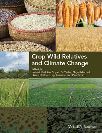Crop Centre in Print
Please find the latest journal publications from the Crop Centre listed below.
For a full list of publications from the School of Life Sciences please visit the Latest Journal Publications
Volatiles from biofumigant plants have a direct effect on carpogenic germination of sclerotia and mycelial growth of Sclerotinia sclerotiorum

- Warmington, R . Clarkson, P.J
Sclerotia of Sclerotinia sclerotiorum survive in soil and germinate to produce apothecia which release airborne ascospores. Current control methods rely predominantly on the use of fungicides to kill ascospores. The aim of this research was to identify potential biofumigation treatments which suppress sclerotial germination, providing a potential alternative and long-term approach to disease management.
Crop Wild Relatives and Climate Change
 Walley, P. G., and Moore, J. D. (2015). Biotechnology and genomics helping to understand and uncover the hidden potential of Crop Wild Relatives.
Walley, P. G., and Moore, J. D. (2015). Biotechnology and genomics helping to understand and uncover the hidden potential of Crop Wild Relatives.
In: Crop Wild Relatives and Climate Change (Yadav, S., Redden, B., Fowler, C., Maxted, N., Smith, P., Guarino, L., Snook, L., Dullo, E., eds). ISBN: 978-1-118-85433-4; Wiley-Blackwell.
Two major challenges to continued global food security are the ever increasing demand for food products, and the unprecedented abiotic stresses that crops face due to climate change.
Wild relatives of domesticated crops serve as a reservoir of genetic material, with the potential to be used to develop new, improved varieties of crops.
Crop Wild Relative and Climate Change integrates crop evolution, breeding technologies and biotechnologies, improved practices and sustainable approaches while exploring the role wild relatives could play in increasing agricultural output.
http://eu.wiley.com/WileyCDA/WileyTitle/productCd-1118854330.html
Registration of thermal and visible light images of diseased plants using silhouette extraction in the wavelet domain
 Raza Shan-e-Ahmed, Sanchez Silva Victor, Prince Gillian, Clarkson John P and Rajpoot Nasir M
Raza Shan-e-Ahmed, Sanchez Silva Victor, Prince Gillian, Clarkson John P and Rajpoot Nasir M
The joint analysis of thermal and visible light images of plants can help to increase the accuracy of early disease detection. Registration of thermal and visible light images is an important pre-processing operation to perform this joint analysis correctly. This paper proposes an algorithm for registration of thermal and visible light images of diseased plants based on silhouette extraction. Experimental results show that silhouettes extracted using this method can be used to register thermal and visible light images with high accuracy.
Pattern Recognition. July 2015
Identification of novel pesticides for use against glasshouse invertebrate pests in UK tomatoes and peppers

George DR, Banfield-Zanin JA, Collier R, Cross J, Birch ANE, Gwynn R, O'Neil T
To inform current and future pesticide availability to glasshouse vegetable growers, the current project trialled more than twenty products, including existing industry standards, against four key pests of glasshouse tomatoes and bell peppers. These included experimental conventional chemical pesticides as well as alternative biopesticide and biorational products based on phytochemicals, microbials and physically-acting substances. The results suggest that certain biopesticide products, particularly botanicals, provide good levels of pest control, with the same being true of experimental conventional chemical pesticides not yet recommended for use against these pests on these crops. Efforts are on-going to ensure that results of the current project translate to industry benefit via new pesticide approvals.
Insects 2015, 6(2), 464-477; doi:10.3390/insects6020464 Issue 2
Automatic detection of diseased tomato plants using thermal and stereo visible light images.
Automatic detection of diseased tomato plants using thermal and stereo visible light images.
 Raza SE, Prince G, Clarkson JP, Rajpoot NM
Raza SE, Prince G, Clarkson JP, Rajpoot NM
Thermal imaging provides a fast and non-destructive way of scanning plants for diseased. However, this has been known to be affected by environmental conditions which include leaf angles and depth of the canopy areas accessible to the thermal imaging camera. In this paper, we combine thermal and visible light image data with depth information and develop a machine learning system to remotely detect plants infected with the tomato powdery mildew fungus Oidium neolycopersici. Our approach is capable of identifying plants which were not originally inoculated with the fungus at the start of the experiment but which subsequently developed disease through natural transmission.
PLoS One. April 2015
Articles in May 2015 issue of HDC News
Research and other activity at Warwick Crop Centre is featured in articles in the May edition of HDC News http://www.hdc.org.uk/publication/hdc-news-may-issue-213. This includes:
- Pest bulletin: first forecasts pubblished p6
- Crop nutrition on the menu p12
- Unearthing fusarium's hidden secrets p14
- Primed against pests p24
- SCEPTRE for brassicas: the final analysis p26
